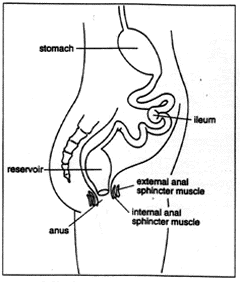Ileoanal Anastomosis Illustrations
Figure 1. Normal Gastrointestinal Anatomy and Physiology

Return to "What is a J-Pouch?What is J-Pouch Surgery?"
Figure 2, Stage 1: Ileoanal Reservoir Surgery

Return to "What is J-Pouch Surgery?"
Figure 3, Stage 1 continued: Ileoanal Reservoir Surgery

Return to "What is J-Pouch Surgery?"
Figure 4, Stage 2: Gastrointestinal tract after Ileoanal Reservoir Surgery

Return to "What is J-Pouch Surgery?"
- Illustrations by Bonnie Rolstad as appeared in: Hurd B: Presenting a Patient guide to ileoanal reservoir surgery. Ostomy Wound Management 1992;38(5):52-60


